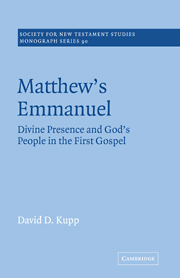Book contents
- Frontmatter
- Contents
- Preface
- List of abbreviations
- 1 Introduction
- 2 Matthew's narrative art
- 3 Reading Matthew's story of divine presence
- 4 Paradigms of presence in the Old Testament
- 5 ‘I am with you’: the Old Testament tradition of the saying
- 6 Matthew 1: the birth of the ‘God-with-us’ Messiah
- 7 Matthew 18.1–20: the presence of Jesus and his έκκλησία
- 8 Matthew 28.16–20: the presence of the risen Jesus
- 9 Jesus' presence and Matthew's christology
- 10 Conclusion
- Bibliography
- Index of passages
- Index of authors
4 - Paradigms of presence in the Old Testament
Published online by Cambridge University Press: 19 January 2010
- Frontmatter
- Contents
- Preface
- List of abbreviations
- 1 Introduction
- 2 Matthew's narrative art
- 3 Reading Matthew's story of divine presence
- 4 Paradigms of presence in the Old Testament
- 5 ‘I am with you’: the Old Testament tradition of the saying
- 6 Matthew 1: the birth of the ‘God-with-us’ Messiah
- 7 Matthew 18.1–20: the presence of Jesus and his έκκλησία
- 8 Matthew 28.16–20: the presence of the risen Jesus
- 9 Jesus' presence and Matthew's christology
- 10 Conclusion
- Bibliography
- Index of passages
- Index of authors
Summary
We have looked at some rhetorical features of Matthew's presence motif through the prism of narrative criticism. The same motif can be investigated referentially, i.e., via its literary, historical and social correspondences in Matthew's first-century CE world. For Matthew the Jewish scriptures are his most obvious touchstone. An investigation of OT divine presence will help to clarify the key social and religious context from which Matthew's presence motif was drawn. The discussion of divine presence in the OT and in recent commentary is potentially vast. It is important to outline some parameters for the relatively brief engagement of the issue here.
(1) In reflection of their importance in OT narrative, I am engaging with three basic models of divine presence provided by the patriarchal, Sinaitic and Davidic streams of theology. This chapter will outline some of the essential distinctives and convergences of divine presence in these traditions.
(2) I am not elaborating these models in strict dependence on an existing source theory. Although many critics hold that the basic insights of pentateuchal criticism remain intact in the midst of recent criticism, more important is the question of how the OT models of presence may have appeared to a first-century CE Matthew.
Literature and current discussion
Talking about ‘OT presence theology’ touches on two larger, related discussions: the centre of OT theology, often ascribed to covenant, and the nature and relationship of the Mosaic/Sinaitic tradition and the Davidic/Zionistic tradition of Jerusalem.
- Type
- Chapter
- Information
- Matthew's EmmanuelDivine Presence and God's People in the First Gospel, pp. 109 - 137Publisher: Cambridge University PressPrint publication year: 1996



